New Alabama sculpture park, Black history museums are changing the way history is told
MONTGOMERY, Ala. ‒ From a wooden bench at the edge of the Freedom Monument Sculpture Park, visitors can see the Alabama River where enslaved Africans were transported and sold into a life of forced labor.
From the wide windows on the second floor of the International African American Museum in Charleston, South Carolina, visitors can look across the Cooper River toward Africa, where people from the continent were kidnapped to be auctioned off.
The sculpture park opens Wednesday. The international museum opened last summer. Both were built on sites considered sacred and important to telling the history of African Americans, to telling the history of America.
“We have to build these places where we can tell the story, save the story, steward the story,’’ said Tonya Matthews, president and CEO of the International African American Museum. “But one of the challenges has been the curation of the story. Who is picking the stories? Who is telling the stories? What stories do we believe should have grand institutions? Arguably, the African American story has not been in the category that was thought to need a grand institution.’’
The museum and monument park are among a growing number of sites across the country opening in the past decade to preserve and celebrate Black History and the Black experience in America. Some are multimillion-dollar museums, while others are housed in small interpretive centers.
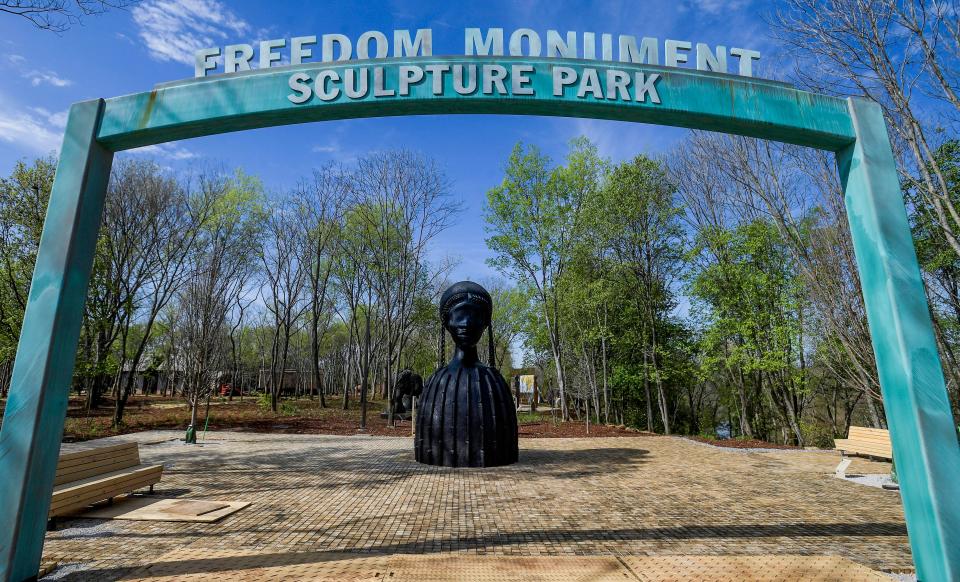
In Mississippi, there is the Civil Rights Museum in Jackson and the B.B. King Museum in the blues legend's hometown of Indianola. In Alabama, the National Memorial for Peace and Justice tells the story of the nation’s troubling history of lynching, and in Washington, D.C., the National Museum of African American History and Culture, showcases the journey of Black people across the United States.
Black museums have long been “cultural anchors’’ in their communities, but it has been only in recent years that more have raised enough money and garnered enough support to open, museum leaders said. The institutions matter even more today as lawmakers in some states push to restrict the teaching of Black history and ban some books that tell this history, experts said.
“History matters in profoundly important ways,’’ said Lonnie Bunch, founding director of the National Museum of African American History and Culture and now secretary of the Smithsonian. “And it's partly museums' job to articulate that and to provide an opportunity to use history to define reality and give hope.”
New sculpture park tells history of slavery in the US
On a recent afternoon, the Alabama River rose so high the boat that would have ferried visitors from downtown Montgomery to the new Freedom Memorial Sculpture Park wasn’t in service. The voyage is intended to introduce visitors to the site along the waterway enslaved people traveled.
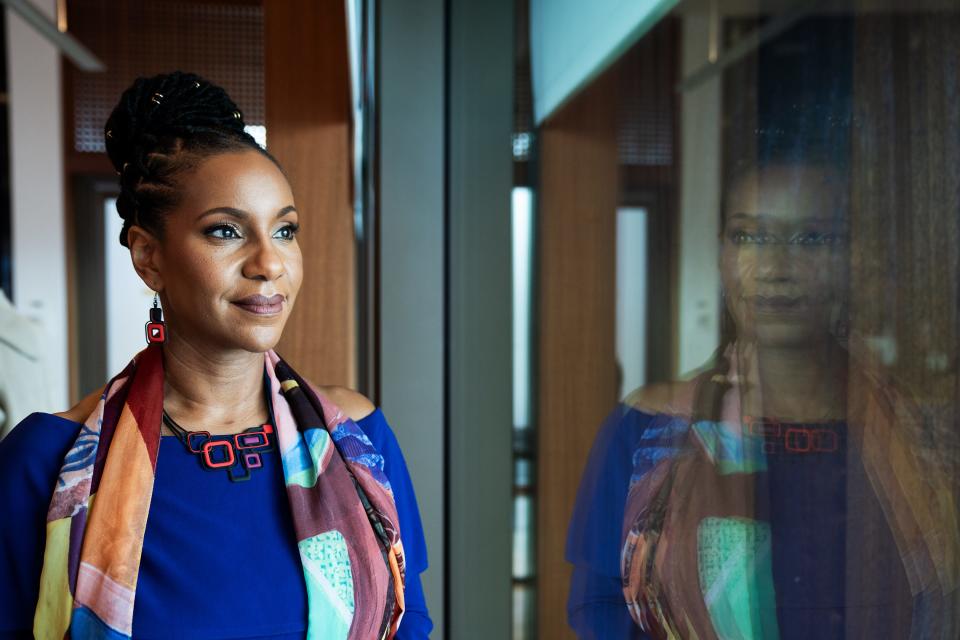
The park, which opens March 27, sits on a 17-acre site between the river and the railroad tracks enslaved people were forced to lay.
Nearly all the works in the park were created by African American, African and Indigenous artists. Some are part of the permanent collection; others are on loan. Each tells a story.
Acknowledging Indigenous people who lived on the land long before Europeans arrived, there are sculptures honoring their culture, their presence, their resilience. A bronze sculpture created by Allan Houser pictures a man hunting buffalo. Steps away stands Cliff Fragua's “Three Sisters,’’ made of Utah alabaster.
Further along the path, a map tracing the Transatlantic Slave Trade shows nearly 3 million people were trafficked from Luanda, Angola, from 1501 to 1867.
Wooden pillars report dates and counties where enslaved people were brought. From 1619 to 1774, 3,996 were taken to Hampton, Virginia.
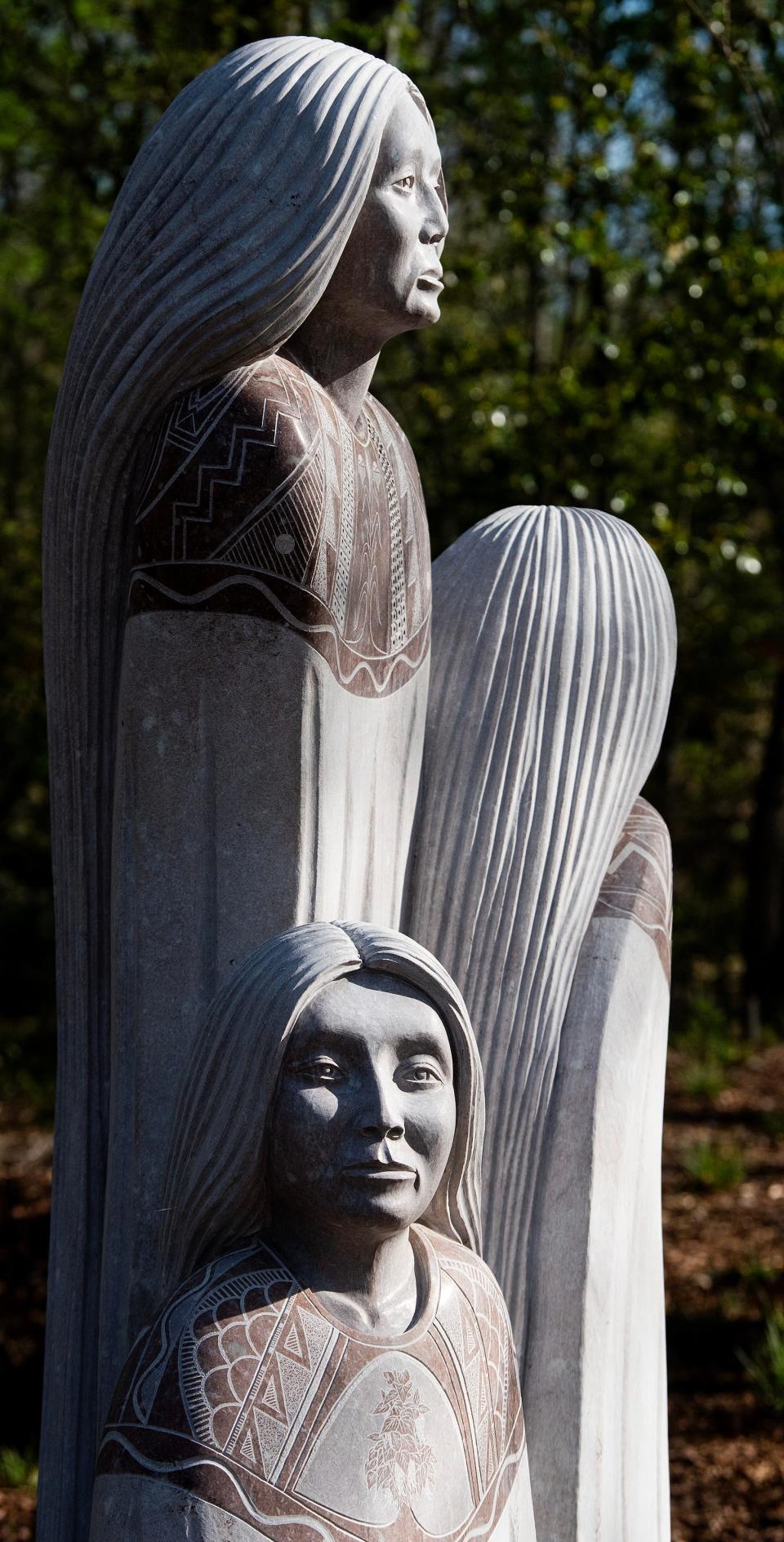
Visitors walk along a trail made with resin to make it feel more like earth. They can read ''slave laws'' that banned enslaved people from traveling off plantations without written permission. Punishments included floggings, sometimes death.
The narrative of William Wells Brown tells the story of his escape from slavery. (He went on to lecture against slavery and write what is considered the first novel by an African American.)
There is “Last Seen,’’ panels featuring ads posted by people searching for wives, mothers, husbands. Many spent their last nickels and dimes looking for loved ones, said Bryan Stevenson, who created the park and founded the Equal Justice Initiative, a human rights organization pushing to end mass incarceration.
“That just reinforces how much for enslaved people the most important thing about slavery was the ability to love someone, to find your children, your siblings, your parents,’’ Stevenson told USA TODAY in an interview ahead of the park's opening. “That was powerful.”
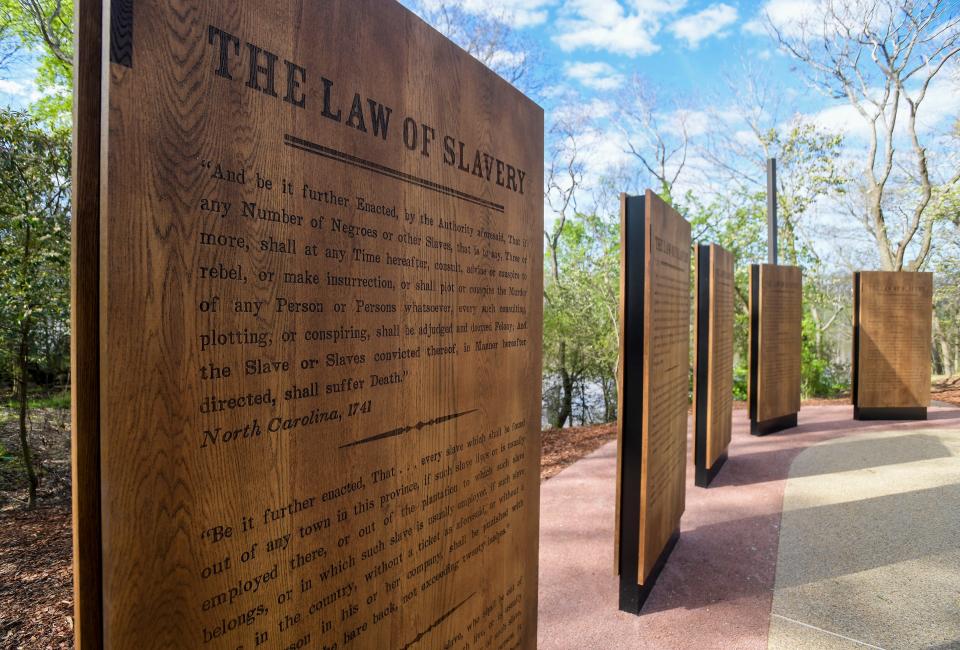
Near the end of the path, visitors look toward the sky at the National Monument to Freedom, a 43-foot-high, 155-foot-wide steel structure that bears 122,000 ''unique'' surnames adopted by Black people in the 1870 Census. It was the first count where enslaved Black people were listed by name.
Plans for the wall went from 20 feet high to 30 feet to 43 feet. ‘‘The history of our people deserves to be on something big,’’ Stevenson said.
Part of the inscription Stevenson wrote for the wall reads: “The country you built must honor you. We acknowledge the tragedy of your enslavement. We commit to advancing freedom in your name.’’
Black museums are about storytelling
Museums bring in lifelong learners, while artifacts help humanize history, Bunch said. They teach visitors about slavery, for instance, through the tale of a family or a plantation.
“They're all about storytelling, making you care about the people whose histories you explore,’’ Bunch said.
Since the Smithsonian’s National Museum of African American History and Culture opened in 2016, people have been more interested in visiting their local museums and creating new ones, said Vedet Coleman-Robinson, executive director of the Association of African American Museums.
The museum had 1.6 million visitors last year.
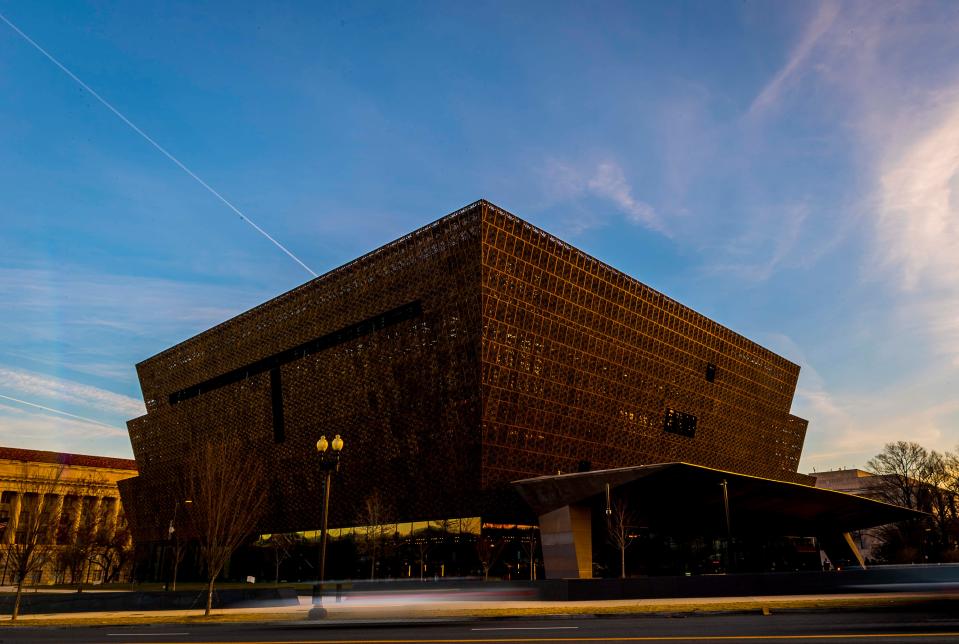
Today, there are about 300 African American-focused museums, including virtual ones. More are scheduled to open soon, including the National Urban League’s Civil Rights Museum in Harlem, the Go-Go Museum in Washington, D.C, The Hip Hop Museum in the Bronx, and the National Juneteenth Museum in Fort Worth, Texas.
“Now is the time for people to really get familiar with our museums and our history,’’ Coleman-Robinson said. “We’re past due.”
The early Black museums opened decades ago because the history of African Americans wasn’t included in mainstream institutions, Coleman-Robinson said. “Our museums have really been voices for their communities.’’
Charleston highlights local Black history
It’s not lost on visitors to the International African American Museum at what was once the busiest slave port in Northeast America, where hundreds of thousands of Africans were brought to Gadsden’s Wharf to be sold into generations of slavery.
The idea for the museum began about 20 years ago, and plans changed and expanded over the decades.

“It became clear that Charleston didn't just need to tell its own story ‒ that we were the linchpin in the much larger story of that beginning period of slavery in America,’’ Matthews said.
More than 100,000 people have visited since the museum opened last summer.
In addition to its focus on slavery, museum visitors explore the history of Africa and the African diaspora. They also learn about the region's rich arts and culture.
“The circle got even wider, and folks decided that … this period of slavery is neither the beginning nor the end of the African American journey,’’ Matthews said.
On one recent afternoon, Suzanne Johnson sat on a bench inside the Praise House exhibit at the museum. She hummed along as she watched a video of people singing and celebrating the rich Gullah Geechee culture. She watched it again, then again.
The stop at the museum last month was a must for Johnson and her daughter, Cameron Mine, who were visiting from Miami. They spent hours in the museum seeing exhibits like the slave tags Black people had to wear. There was #758 porter, #672 servant. There was a black wall listing names forced on enslaved Africans and another with names they came with like Cando, Tooguah and Sannar.

The Praise House particularly stirred emotions for Johnson, whose grandmother has roots in South Carolina.
“If they take our stories from us, we cease to exist,” said Johnson, 51. “The beauty of this museum is it weaves our stories together.’’
Johnson believes museums are necessary especially now to counter restrictions like in her home state of Florida, where the College Board's Advanced Placement African American Studies course was banned. “They’re trying to stifle our story,’’ she said.
Johnson was excited to see that next to the Praise House, construction for new exhibits had begun. “I intend to grow with the museum,’’ she said.
'Igniting a cultural renaissance'
Museums help expand public education about African American history, said Brent Leggs, executive director of the African American Cultural Heritage Action Fund and senior vice president of the National Trust for Historic Preservation, the nonprofit that established the fund.
“We're at a moment of igniting both cultural reckoning around the gaps in the American story and the need to more equitably interpret American history,’’ Leggs said. “We’re also igniting a cultural renaissance.”
Matthews, of the International African American Museum, said there is finally a recognition that the African American story doesn’t just fit in an art gallery and that it should be included in every museum focused on American history.
“There is also room to have entire spaces dedicated to the story so we can get into the nuances, so we can talk about it from different perspectives,’’ Matthews said.
Heaven Campbell and Karissa Pelichet stopped at the painting of a family in the international museum, discussing the pain of learning the father had been lynched.
The sophomores from North Carolina A&T State University were recently in Charleston to visit the museum and learn more about the city’s Black history. They had also booked a Black Heritage walking tour for that afternoon.
“We love Black History and how it shows how far we’ve come,’’ said Pelichet, 20.
The roommates had visited other museums in the past, including The King Center in Atlanta and the National Museum of African American History and Culture. “It ties everything together,” Pelichet said of the visits.
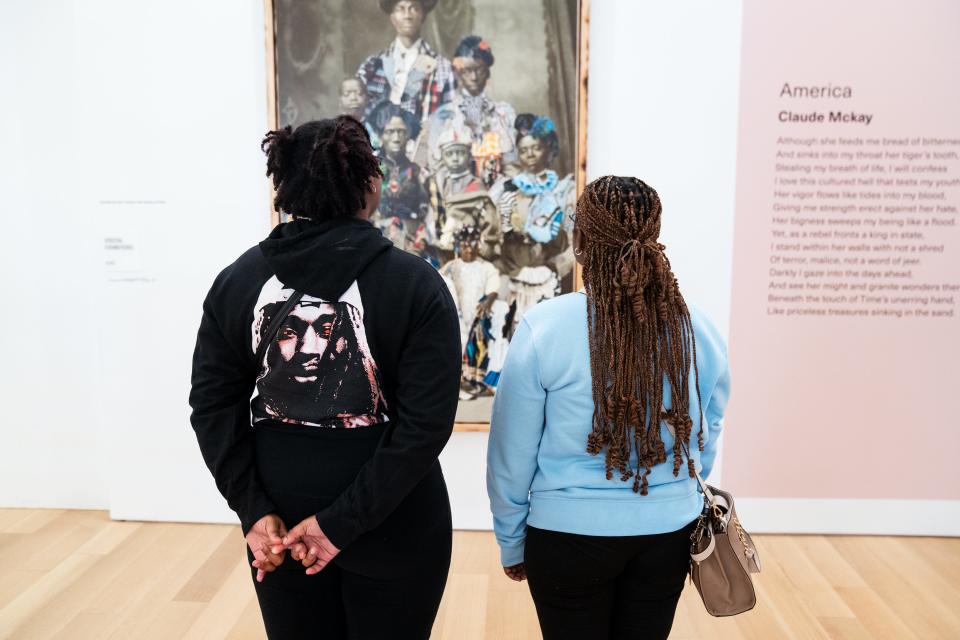
Campbell, who has taken several African American study classes, said it’s on people to explore their heritage.
“We can’t depend on the public school system to teach our history,’’ said Campbell, 20, adding that visiting museums is only part of learning about Black history. “It should be a stepping stone, but not our only stepping stone.”
Black history restrictions spur more interest
The push to teach more Black history comes as dozens of states, including Florida, Texas and Oklahoma, have adopted or proposed measures that critics say omit crucial parts of Black history. Some have also banned books, many of them by Black authors that focus on race.
The restrictions have spurred more people to educate themselves, museum leaders said.
‘’The more we try to clamp down on some things, frankly, the more people are talking about it and then they start to seek out places to find this story,’’ Matthews said. “Many will look for specifically authentic places.’’
That’s often a Black museum, experts said.
“The broader public understands that museums and historic sites are supplemental places of knowledge and education and are critically important at this moment in our history,’’ Leggs said.
Bunch said there will always be interest in Black museums regardless of political pushback.
“You want to make sure that those museums are strong so when the pendulum swings and more and more people are coming to the subject, they have good museums to explore.’’
To learn more: Black churches in Florida buck DeSantis: 'Our churches will teach our own history.'
The Freedom Monument Sculpture Park is the latest of three EJI history projects in Montgomery. More than 2 million people have visited the National Memorial for Peace and Justice and the Legacy Museum since they opened in 2018.
Stevenson called the response ‘’affirming’’ and ‘’encouraging.’’
“That has helped me believe that what we're doing can have an impact and has power, and we should keep trying to do it,’’ he said.
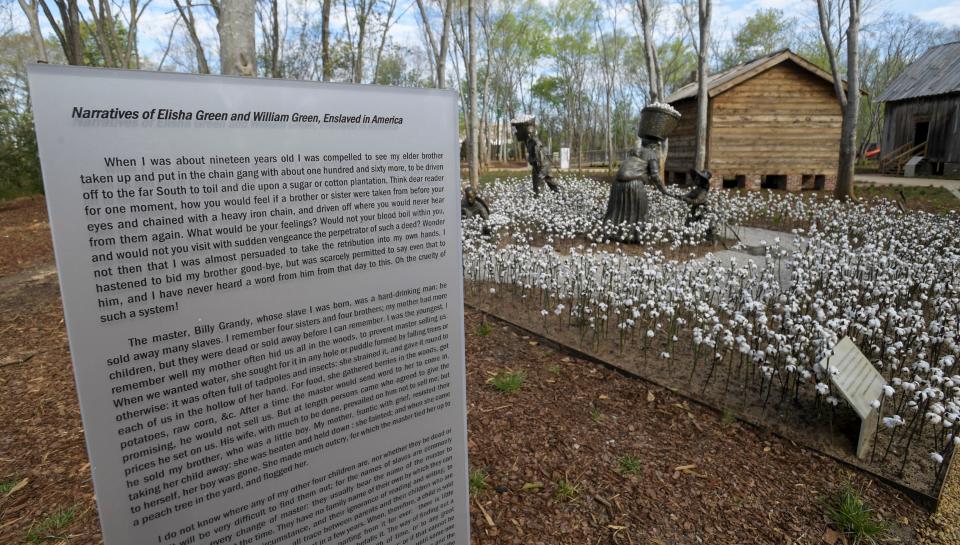
The reaction to their first two sites led the EJI to create the sculpture park with its focus on slavery. “I really hope that we begin to understand that the institution of slavery created harms that have a legacy and that we need to understand those harms,’’ Stevenson said.
'An investment well worth making'
Not all new Black museums are mega structures. Some focus on one person or moment in history. Some don’t have a building at all. The Sankofa Mobile Museum recently visited schools in Prince George’s County, Maryland, teaching local Black history.
An old storefront in Sumner, Mississippi, houses the Emmett Till Interpretive Center and features exhibits about the 14-year old Black teenager who was murdered by white men in Mississippi in 1955. Emmett’s death was a catalyst in the Civil Rights Movement.
Other new opportunities: Several Black museums have opened in recent years with more coming soon. Here's a list.
The center opened in 2016. Last summer, President Joe Biden signed a proclamation establishing the Emmett Till & Mamie Till-Mobley National Monument at three historic sites in Mississippi and Illinois, where Emmett was from.
“It really is going to be a place more of reflection so people can think about (what happened),’’ said Daphne Chamberlain, a civil rights historian in Mississippi who is working with the center. "It's always important that we remember, and if we don't remember, what we're also doing is subscribing to all of these attacks on Black history.’’
African American historic sites have long been underfunded and undervalued, experts say.
The African American Cultural Heritage Action Fund has received more than 6,000 requests totaling $700 million in the past six years, including some from museums and historic sites.
Leggs said there aren’t enough funders for such preservation projects. “This is critically important, but this funding is often short-term gap investing,’’ he said.
More local communities should support Black museums, Leggs said, particularly since many are “cultural anchors.’’
The price tag for the International African American Museum grew to $100 million. It received money from private and public entities, including the state, county and city.
“Ask and you shall receive, but ask many, many times,’’ Matthews said.
Museum officials made the case that the new institution would fit with the region's brand of promoting its history. Matthews says that “is what began to make folks more and more comfortable.''
It has been only in more recent years that there has been the capability to build some Black museums, Stevenson said. He doesn’t believe the Equal Justice Initiative could have done it 10 years ago.
“We didn't have the ability to create institutions with autonomy like the institutions that we've created, but now we do,’’ Stevenson said. “We have resources. We have capacity. We just have to make sure we have vision.’’
EJI doesn’t take government funding. Visitors pay $5 for admission to the sites to keep it affordable.
The cost for the sculpture park, where construction is still underway, is expected to climb to about $20 million.
“What we did on the other two sites has made me believe it's an investment well worth making,’’ said Stevenson, adding that the response has been overwhelming. “When I hear some of the things I hear, when the students come through and people come through, there’s no limit to what I would spend to try to create that kind of consciousness.”
This article originally appeared on USA TODAY: Black history's fresh voice: How new museums curate complex stories

